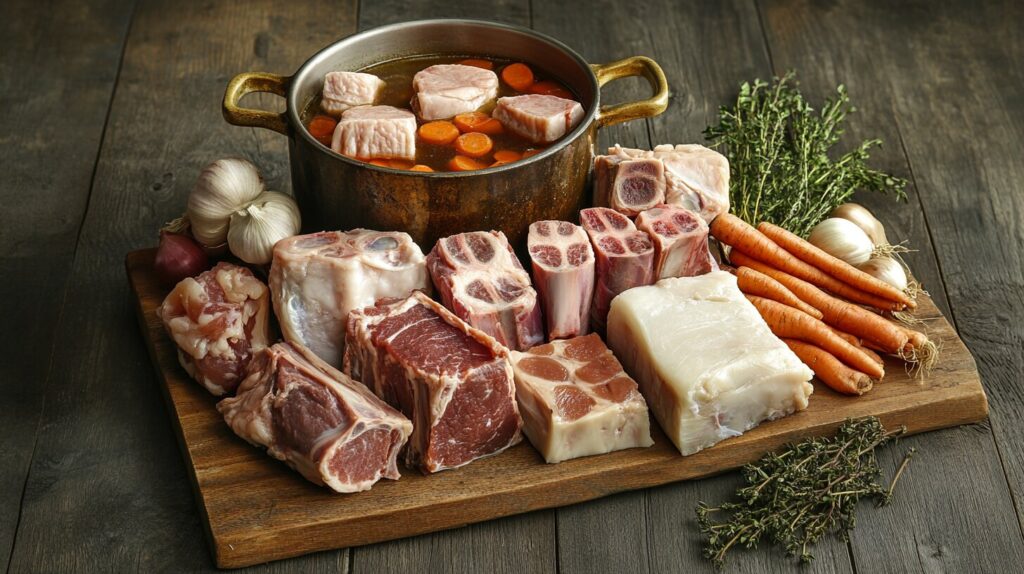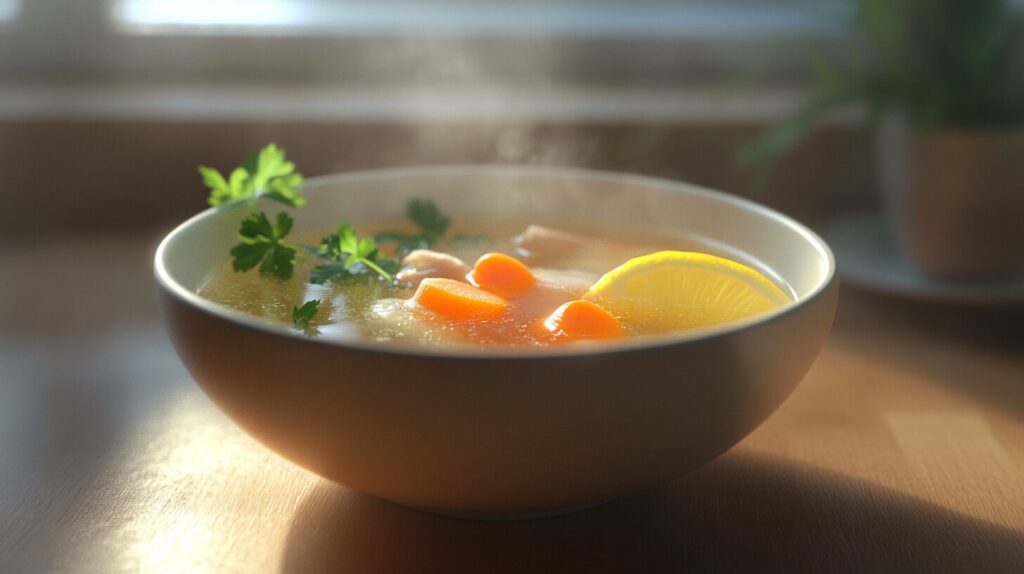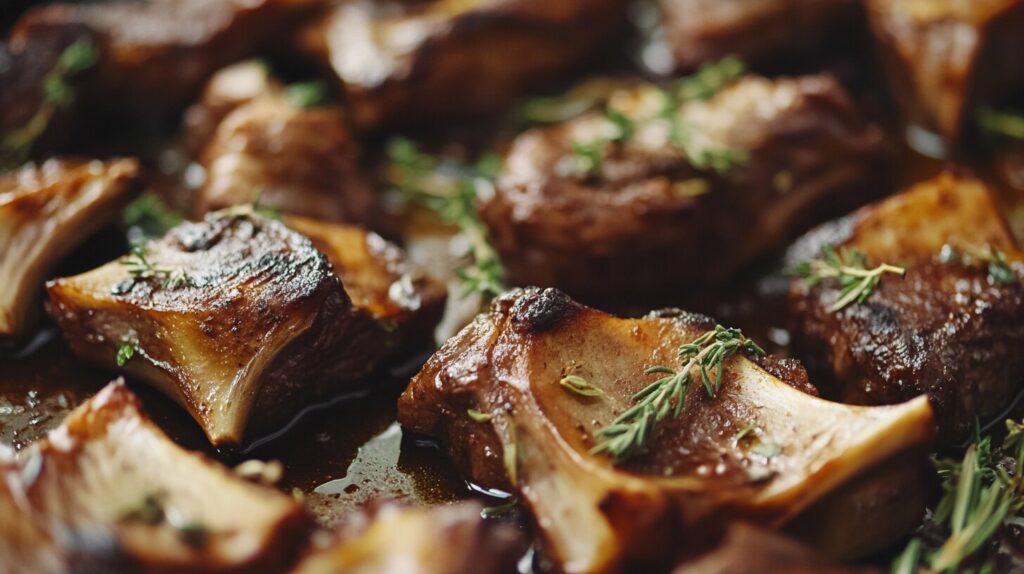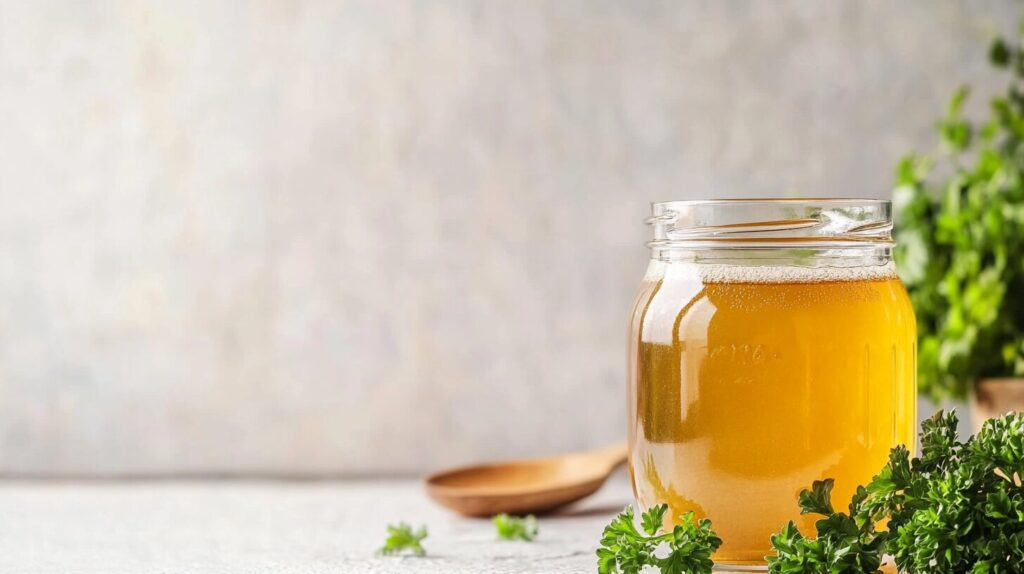
Nothing beats the comfort of a warm, steaming bowl of homemade soup. It’s like a hug in a bowl, right? But what makes that bowl of soup go from just “good” to “absolutely divine” is often hiding beneath the surface: the bones. Yes, the bones you use play a massive role in crafting the perfect broth. If you’re here to learn what are the best bones for soup (without any pork ingredients), you’re in the right place. Whether you’re cooking a hearty beef stew, a delicate chicken consommé, or a robust fish broth, choosing the right bones can elevate your dish to new heights.
Let’s dive into the world of bones and broths, and discover the secrets to making soups that’ll leave your taste buds singing.
Table of Contents
The Importance of Choosing the Right Bones for Soup
Why do the best bones for soup matter so much in soup making? Think of bones as the building blocks of flavor. When you simmer bones for hours, you’re unlocking a treasure trove of taste and nutrition. The marrow, cartilage, and connective tissues break down, releasing gelatin, minerals, and collagen. This is what gives soups that rich mouthfeel, velvety texture, and deep, satisfying taste.
🦴 Bones = Flavor + Nutrition
Bones not only provide that umami-packed punch but also offer health benefits. Gelatin aids digestion, collagen is great for your skin, and minerals like calcium and magnesium are essential for bone health. Using high-quality bones ensures you’re getting the best of both flavor and nutrition.
🗨️ “Good soup is one of the prime ingredients of good living.” — Louis P. De Gouy
Nutritional Benefits of Bone-Based Soups
Ever wonder why your grandmother insisted on chicken soup when you were sick? It’s not just an old wives’ tale. Bone-based soups are nutritional powerhouses. Here’s why:
- Rich in Collagen and Gelatin: These two compounds are excellent for joint health, skin elasticity, and gut health.
- Packed with Minerals: Bones release calcium, phosphorus, magnesium, and potassium into the broth, which are essential for bone strength and overall well-being.
- Boosts Immunity: The amino acids (like glycine and proline) released during simmering help support the immune system.
- Supports Digestive Health: Gelatin helps repair the gut lining and aids in digestion.
Drinking bone broth is like giving your body a nutrient boost wrapped in a cozy, comforting sip.
Types of Bones for Soup and Their Characteristics
Now, let’s break down the best types of bones for soup and what each offers in terms of flavor and texture. Each type of bone brings something unique to the table, so knowing which one to use can help you achieve the perfect soup every time.
Chicken Bones: A Versatile Option for Clear and Rich Broths

When it comes to making a versatile broth, chicken bones are some of the best bones for soup. They’re light, easy to find, and work in everything from classic chicken noodle soup to more complex dishes.
- Flavor Profile: Light, savory, and clean.
- Best Bones to Use: Carcass, wings, drumsticks, and necks.
- Best Uses: Chicken soup, ramen, consommé, and risotto.
Chicken bones create a clear broth with a subtle yet rich flavor. Perfect for when you want comfort without too much heaviness.
Beef Bones: Creating Hearty and Flavorful Soups
Looking for something hearty and robust? Beef bones are among the best bones for soup when you want rich and satisfying flavor. They make soups that are rich, dark, and deeply satisfying.
- Flavor Profile: Bold, umami-rich, and slightly earthy.
- Best Bones to Use: Knuckles, marrow bones, oxtail, and shank bones.
- Best Uses: Pho, beef stew, French onion soup, and ramen.
Pro Tip: Roasting beef bones before simmering them intensifies their flavor and gives the broth a beautiful, caramelized depth.
Lamb Bones: Adding Depth and Distinctive Taste
Lamb bones are less common but offer a distinctive, slightly gamey flavor perfect for rich, complex soups.
- Flavor Profile: Bold, slightly sweet, and earthy.
- Best Bones to Use: Shanks, neck bones, and shoulder bones.
- Best Uses: Lamb stew, Middle Eastern soups, and hearty vegetable soups.
If you want to try something new, lamb bone broth can give your soups a unique twist that’s both comforting and exotic.
Turkey Bones: Seasonal, Nutritious, and Flavorful
Got leftover turkey bones from Thanksgiving? Don’t throw them out! Turkey bones make a nutrient-rich broth that’s perfect for seasonal soups.
- Flavor Profile: Rich, slightly deeper than chicken, but still clean.
- Best Bones to Use: Carcass, wings, and neck.
- Best Uses: Turkey noodle soup, wild rice soup, and vegetable soups.
Turkey bones are like the bigger, bolder cousin of chicken bones. Ideal for when you want a richer broth.
Fish Bones: The Secret to Perfect Seafood Broth
For seafood lovers, fish bones are a game-changer. They create a light, flavorful broth that’s perfect for seafood dishes.
- Flavor Profile: Delicate, briny, and clean.
- Best Bones to Use: Heads, frames (skeleton), and tails.
- Best Uses: Bouillabaisse, fish stew, miso soup, and chowders.
Tip: Avoid oily fish like salmon for broths, as they can make the soup greasy. White fish bones are the best for clear, flavorful broths.
🗨️ “Soup is cuisine’s kindest course.” — Virginia Woolf
How to Source the Best Bones for Your Soup
Finding the best bones is key to making top-notch broth. Here’s how to make sure you’re getting the good stuff.
Choosing Fresh vs. Frozen Bones
- Fresh Bones: Ideal for maximum flavor and nutrients. Look for bright, moist bones with no off-putting odors.
- Frozen Bones: Convenient and great for stocking up. Just make sure they’re vacuum-sealed and free of freezer burn.
Organic and Grass-Fed Options for Healthier Soups
Whenever possible, opt for organic or grass-fed bones. These bones come from animals raised without hormones or antibiotics, which means cleaner, healthier broths.
- Benefits: Higher in nutrients, better taste, and no harmful additives.
Sustainable Practices When Selecting Bones
Sourcing bones from local farms or butchers who practice ethical farming ensures you’re making a choice that’s good for the environment and your health. Plus, supporting local farmers is always a win-win!
How to Prepare Bones for the Best Flavor Extraction
Preparing your bones properly before simmering is crucial for getting the most flavor and the clearest broth. It might seem like an extra step, but trust me—it makes all the difference. Let’s break down the key techniques you should use to prep your bones like a pro.
Roasting Bones for Enhanced Depth and Taste

Roasting bones before boiling them is one of the best-kept secrets for flavor-packed soups. Why does this work? Because roasting caramelizes the natural sugars and proteins in the bones, resulting in a deeper, richer flavor.
Steps to Roast Bones:
- Preheat your oven to 400°F (200°C).
- Place the bones on a baking sheet lined with parchment paper.
- Roast for 30–45 minutes, turning occasionally until the bones are golden brown.
- Add vegetables like onions, carrots, and garlic to the pan for extra flavor.
When you add these roasted bones to your pot, the resulting broth will have a wonderful depth and a slightly nutty flavor. This is especially great for beef and lamb bones! 🦴🔥
Blanching Bones to Remove Impurities
If you want a clear, clean broth, blanching is a step you shouldn’t skip. Blanching removes blood, impurities, and any unwanted particles that can cloud your broth.
Steps to Blanch Bones:
- Place the bones in a large pot and cover them with cold water.
- Bring the water to a boil and let it boil for 5–10 minutes.
- Drain the water and rinse the bones under cold running water.
- Scrape off any scum or residue clinging to the bones.
Blanching is particularly useful for chicken, turkey, and beef bones. It results in a broth that’s both visually appealing and free of any unpleasant flavors.
Combining Different Types of Bones for Complex Flavors
Want to take your broth to the next level? Try combining different types of bones. Mixing bones with different qualities—like gelatin-rich knuckles with flavor-packed marrow bones—creates a more complex and well-rounded broth.
- Chicken + Beef: The lightness of chicken with the richness of beef creates a balanced and versatile broth.
- Beef + Lamb: Perfect for hearty stews and soups that need a bold flavor punch.
- Fish + Shrimp Shells: Adds layers of seafood flavor for a refined, aromatic broth.
Experiment with combinations to see what suits your tastes best. The possibilities are endless!
Common Problems When Making Bone Broth and Their Solutions
Even experienced cooks can face challenges when making bone broth. But don’t worry! Here are some common problems and easy fixes to help you perfect your soup every time.
Why Does My Broth Taste Bland?
A bland broth is disappointing, but it’s easy to fix!
Causes:
- Not using enough bones or aromatics.
- Skipping the roasting step.
- Not simmering long enough.
Solutions:
- Add more bones or a wider variety of bones.
- Roast the bones for added depth of flavor.
- Simmer for a longer time—aim for at least 6–8 hours for beef and 3–4 hours for chicken.
- Season with salt, herbs, and a splash of acid (like lemon juice or vinegar) to brighten the flavors.
How to Prevent Cloudy Broth
Clear broth is a mark of a well-made soup. If yours is cloudy, here’s why:
Causes:
- Boiling the broth too vigorously.
- Not blanching the bones.
- Stirring too much while simmering.
Solutions:
- Keep your broth at a gentle simmer, not a rolling boil.
- Blanch the bones before cooking to remove impurities.
- Avoid stirring the broth during cooking. Let it do its thing!
Dealing with Too Much Fat in the Soup
Too much fat can make your soup greasy and heavy. Here’s how to fix it:
Solutions:
- Skim the fat off the surface with a ladle while the broth is simmering.
- Refrigerate the broth overnight; the fat will solidify on the surface, making it easy to remove.
- Use a fat separator for a quick and effective method.
Cooking Techniques to Get the Best Results
The method you use to cook your bones affects the final taste and texture of your broth. Let’s explore some tried-and-true techniques.
Stovetop Method for Bone Broth
The stovetop method is the classic way to make bone broth. It requires a bit of time and patience, but the results are worth it.
Steps:
- Place bones and aromatics (onions, carrots, celery) in a large pot.
- Cover with cold water (enough to submerge the bones).
- Bring to a boil, then reduce to a gentle simmer.
- Skim off impurities that rise to the top.
- Simmer for 3–8 hours, depending on the type of bones (chicken needs less time, beef more).
- Strain the broth and enjoy!
Slow Cooker Method for Convenience and Rich Flavor
Don’t want to babysit a pot on the stove all day? The slow cooker method is your best friend.
Steps:
- Add bones, aromatics, and water to your slow cooker.
- Set on low and cook for 8–12 hours (or even up to 24 hours for maximum flavor).
- Strain the broth and enjoy your hands-off masterpiece!
Bonus: Your house will smell amazing all day! 🥣
Pressure Cooker (Instant Pot) for Quick and Tasty Broth
Short on time? The Instant Pot or pressure cooker can deliver a rich broth in a fraction of the time.
Steps:
- Add bones, aromatics, and water to the Instant Pot.
- Set to high pressure for 60–90 minutes.
- Allow natural pressure release for the best flavor extraction.
- Strain the broth and you’re done!
The pressure cooker method is perfect for busy days when you need a quick, nutritious boost.
Herbs, Spices, and Vegetables That Complement Bone Broths
A good bone broth can stand on its own, but adding the right herbs, spices, and vegetables can take it to the next level.
Classic Aromatics: Onion, Garlic, and Carrot
These three are the holy trinity of broth-making. They add sweetness, depth, and a comforting aroma.
- Onion: Adds subtle sweetness and body.
- Garlic: Brings a punch of flavor and depth.
- Carrot: Balances the flavors with natural sweetness.
Herbs for Depth and Fragrance: Thyme, Bay Leaf, and Parsley
- Thyme: Adds an earthy, savory note.
- Bay Leaf: Gives a subtle, slightly floral aroma.
- Parsley: Brightens the broth with fresh, grassy notes.
These herbs are like the finishing touches that make your broth sing. 🌿
How Long to Simmer Different Types of Bones for Maximum Flavor
Patience is key when making bone broth. Simmering bones for the right amount of time ensures you extract all the flavor, gelatin, and nutrients they have to offer. But different bones need different simmering times. Here’s a guide to help you get the best results every time.
Chicken Bones
Chicken bones are more delicate compared to beef or lamb bones. They release their flavor and nutrients relatively quickly.
- Simmering Time: 3 to 4 hours
- Tips: Add a splash of apple cider vinegar to help extract more gelatin. Don’t overcook, as chicken bones can disintegrate and cloud the broth.
Beef Bones
Beef bones are dense and packed with collagen and marrow, which take longer to break down.
- Simmering Time: 8 to 12 hours (or up to 24 hours for maximum richness)
- Tips: Roast the bones first to enhance the flavor. The longer you simmer, the more nutrients and gelatin you’ll extract.
Lamb Bones
Lamb bones fall somewhere between chicken and beef in terms of density. They need a moderate amount of time to release their goodness.
- Simmering Time: 6 to 8 hours
- Tips: Lamb broth benefits from robust herbs like rosemary or thyme to balance its slightly gamey flavor.
Turkey Bones
Turkey bones are similar to chicken but larger, so they need a bit more time to break down fully.
- Simmering Time: 4 to 6 hours
- Tips: Turkey broth is excellent with sage, thyme, and bay leaves for a rich, seasonal flavor.
Fish Bones
Fish bones are delicate and quick to release their flavors. Overcooking them can lead to a bitter broth.
- Simmering Time: 30 to 45 minutes
- Tips: Use white fish bones for a clean taste. Add aromatics like fennel and leeks to complement the seafood flavor.
⏳ Remember, slow and steady wins the race when it comes to bone broth. But don’t overdo it—timing matters!
Storage and Freezing Tips for Homemade Bone Broth

So, you’ve made a delicious batch of bone broth. Now, how do you store it to keep it fresh and flavorful? Proper storage techniques can make your broth last for weeks or even months!
Best Containers for Storing Bone Broth
Choosing the right container can prevent spoilage and make reheating easier.
- Glass Jars (Mason Jars): Great for storing in the fridge. Just leave some room at the top for expansion if you plan to freeze.
- Plastic Containers: BPA-free containers work well for freezing.
- Silicone Molds: Perfect for freezing broth in small, usable portions.
- Freezer Bags: Lay them flat for easy stacking and quick thawing.
How to Freeze Bone Broth for Long-Term Use
Freezing is the best way to extend the life of your bone broth. Here’s how to do it:
- Let the broth cool completely.
- Portion the broth into your chosen containers.
- Label with the date so you know how long it’s been stored.
- Freeze for up to 6 months.
Tip: Freeze broth in ice cube trays for quick, single-serving portions perfect for sauces or gravies. 🧊
Reheating Bone Broth
When you’re ready to enjoy your broth again, reheat it safely:
- Stovetop: Simmer gently until hot. Avoid boiling to preserve nutrients.
- Microwave: Heat in short bursts, stirring frequently to ensure even warming.
How to Use Bone Broth in Everyday Cooking
Bone broth is incredibly versatile. It’s not just for sipping on cold days—there are endless ways to incorporate it into your meals. Here are some ideas to inspire you!
As a Base for Classic Soups and Stews
This is the most obvious use, but it never gets old. Use your bone broth as a foundation for soups like:
- Chicken Noodle Soup
- Beef Stew
- Vegetable Soup
- Pho or Ramen
The rich flavor of homemade bone broth will take these classics to a whole new level.
Enhancing Sauces, Gravies, and Rice Dishes
Why use water when you can use bone broth? Replace water with broth in your recipes to add layers of flavor.
- Sauces: Deglaze your pan with broth to create a flavorful sauce for meat dishes.
- Gravies: Use broth as the base for rich, savory gravies.
- Rice and Risottos: Cook rice or risotto in bone broth for added richness.
Drinking Bone Broth for Health and Wellness
Sipping warm bone broth is like a cozy blanket for your insides. It’s perfect for:
- Boosting your immune system during cold and flu season.
- Supporting gut health with its gelatin and collagen content.
- Aiding post-workout recovery thanks to its amino acids and minerals.
Add a pinch of sea salt, a squeeze of lemon, or a dash of herbs for extra flavor.
Bone Broth Recipes Without Pork Ingredients
Ready to put your knowledge to the test? Here are some simple, no-fail bone broth recipes without any pork ingredients. These recipes will give you rich, flavorful broths to enjoy or use in other dishes.
Chicken Bone Broth Recipe
Ingredients:
- 2–3 lbs chicken bones (carcass, wings, necks)
- 2 carrots, chopped
- 2 celery stalks, chopped
- 1 onion, quartered
- 3 cloves garlic
- 2 bay leaves
- 1 tbsp apple cider vinegar
- Water to cover
Instructions:
- Roast the bones at 400°F (200°C) for 30 minutes.
- Add the bones and vegetables to a large pot. Cover with water.
- Add vinegar and bay leaves.
- Bring to a boil, then reduce to a simmer.
- Simmer for 3–4 hours.
- Strain the broth and let it cool.
Beef Bone Broth Recipe
Ingredients:
- 3–4 lbs beef bones (marrow bones, knuckles)
- 2 carrots, chopped
- 2 celery stalks, chopped
- 2 onions, quartered
- 4 cloves garlic
- 2 bay leaves
- 1 tbsp apple cider vinegar
- Water to cover
Instructions:
- Roast the bones at 400°F (200°C) for 45 minutes.
- Add bones and vegetables to a large pot. Cover with water.
- Add vinegar and bay leaves.
- Simmer for 8–12 hours.
- Strain and cool.
Fish Bone Broth Recipe
Ingredients:
- 2 lbs white fish bones (heads, frames)
- 1 leek, chopped
- 2 carrots, chopped
- 2 celery stalks, chopped
- 2 cloves garlic
- 1 bay leaf
- Water to cover
Instructions:
- Add fish bones and vegetables to a pot. Cover with water.
- Bring to a gentle simmer.
- Simmer for 30–45 minutes.
- Strain the broth and cool.
FAQs on the Best Bones for Soup
What are the best bones for making chicken broth?
Chicken carcasses, wings, necks, and drumsticks are ideal for a flavorful, gelatin-rich broth.
How long should I simmer beef bones for broth?
For the best results, simmer beef bones for 8 to 12 hours. Longer simmering releases more nutrients and flavor.
Can I mix different types of bones in one broth?
Absolutely! Combining bones (like chicken and beef) can create a complex and well-rounded flavor.
What’s the best way to store bone broth?
Store bone broth in glass jars, plastic containers, or freezer bags. It lasts 5–7 days in the fridge or up to 6 months in the freezer.
Why is my bone broth cloudy?
Cloudiness usually occurs from boiling too vigorously or not blanching the bones. Keep a gentle simmer and avoid stirring too much.
Do I need to roast the bones before making broth?
Roasting is optional but highly recommended for beef and lamb bones to enhance flavor.
Explore More Soup and Cooking Guides 🍲✨
Now that you know how to pick the best bones for soup, why not dive deeper into the world of soups and cooking techniques? Check out our Everything You Need to Know About Soup Bones for a comprehensive guide on selecting and using soup bones for your next broth. Curious about how soup bones differ from other cuts? Our What are Soup Bones? article breaks it down for you. And if you’re looking for more creative comfort food ideas, don’t miss our step-by-step Ultimate Chicken Dumpling Soup Recipe.
Happy cooking and exploring! 🍲👨🍳✨
